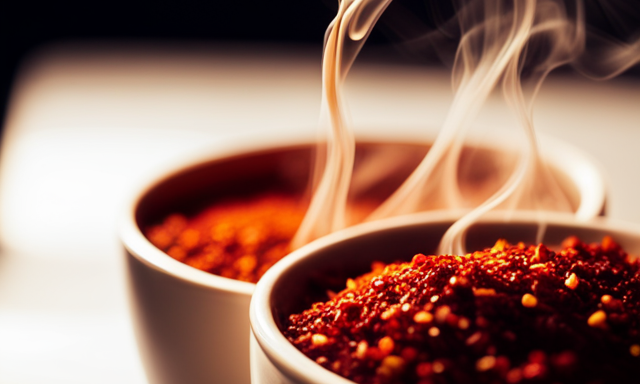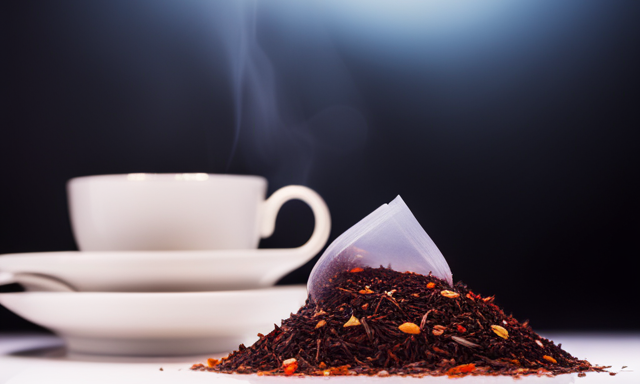Have you ever wondered why they call rooibos tea ‘red tea’?
Well, prepare to have your curiosity satisfied because in this article, I will delve into the origins, flavors, and health benefits of this unique beverage.
As a tea enthusiast, I have always been fascinated by the vibrant red hue of rooibos tea and the rich flavors it offers.
Join me on a journey as we explore the cultivation and harvesting process of rooibos, uncover the secret behind its red color, and discover the various health benefits it provides.
We will also delve into the cultural significance of rooibos tea in South Africa and how it has found its way into modern culinary creations.
So, grab your favorite mug and get ready to learn all about the wonderful world of rooibos tea.
Key Takeaways
- Rooibos tea is called ‘red tea’ because of its vibrant red color during fermentation.
- The fermentation process and exposure to the sun give rooibos tea its red color.
- Rooibos tea is rich in antioxidants and offers numerous health benefits.
- Rooibos tea is deeply rooted in traditional South African culture and healing practices.
The Origins of Rooibos Tea
The Origins of Rooibos Tea can be traced back to the indigenous people of South Africa. They were the first to discover the unique flavor profile of rooibos, a plant that grows exclusively in the Cederberg region.
Rooibos, which means ‘red bush’ in Afrikaans, is called red tea because of the vibrant red color it turns during the fermentation process. This process involves oxidizing the leaves, which enhances the natural flavors and gives rooibos its distinct taste.
The indigenous people of South Africa have been enjoying rooibos for centuries, not only for its delicious flavor but also for its numerous health benefits. It is rich in antioxidants, caffeine-free, and has soothing properties, making it the perfect choice for a relaxing cup of tea.
Discovering the unique flavor profile of rooibos is just the beginning of its remarkable journey.
Discovering the Unique Flavor Profile of Rooibos
Exploring the distinctive taste of Rooibos unveils a flavor profile unlike any other. Its unique flavor is a result of its origins, which can be traced back to the Cederberg region of South Africa. The plants, Aspalathus linearis, thrive in this specific climate, developing their characteristic taste. The flavor of Rooibos is often described as earthy, sweet, and slightly nutty, with a hint of vanilla. To emphasize the complexity of its taste, consider the following table:
| Flavor Notes | Description |
|---|---|
| Earthy | Reminiscent of the soil it grows in |
| Sweet | A natural sweetness, not overpowering |
| Nutty | Delicate nuttiness adds depth |
| Vanilla | Subtle undertones of vanilla |
This combination of flavors creates a rich and satisfying experience. As we delve into the cultivation and harvesting process of Rooibos, we will discover how these flavors are carefully preserved and extracted.
The Cultivation and Harvesting Process of Rooibos
Step into the vibrant world of Rooibos cultivation and harvesting, where you’ll witness the meticulous process of nurturing these remarkable plants in the sun-kissed fields of South Africa.
Cultivation techniques of Rooibos involve careful selection of the right soil conditions and optimal temperatures for growth. These hardy plants require minimal water and are perfectly suited to the arid regions of the Western Cape.
Once the plants have reached their peak, they’re harvested by hand, ensuring that only the finest leaves and stems are selected. Processing methods involve cutting the plants into small pieces and then bruising them, which allows for natural fermentation.
This fermentation process, along with exposure to the sun, is what brings out the distinct red color of Rooibos. Transitioning to the subsequent section, oxidation is the key to Rooibos’ red color.
Oxidation: The Key to Rooibos’ Red Color
To truly appreciate the rich hue of Rooibos, one must delve into the fascinating process of oxidation. This natural transformation is what gives Rooibos its distinctive red color.
During oxidation, enzymes in the leaves interact with air, causing a chemical reaction that changes the composition of the tea. The process begins as soon as the leaves are harvested and exposed to oxygen. The enzymes in the leaves break down the natural compounds, resulting in the release of aromatic oils and the development of the vibrant red color. This oxidation process is carefully controlled to ensure the perfect balance of flavors and colors.
Understanding the role of enzymes in this process helps us appreciate why Rooibos is known as ‘red tea.’
Now, let’s explore the health benefits of this remarkable beverage.
The Health Benefits of Rooibos Tea
Delving into the health benefits of Rooibos tea is like uncovering a treasure trove of wellness. This red tea not only offers a delightful taste, but it also boasts numerous benefits for our bodies.
The antioxidant properties of Rooibos are truly remarkable. These antioxidants help to neutralize harmful free radicals in our system, reducing the risk of chronic diseases and promoting overall health. Additionally, studies suggest that Rooibos tea may have potential anti-inflammatory effects, which can help alleviate symptoms of inflammation in the body. This makes it a great option for individuals with conditions such as arthritis or allergies.
Transitioning into the subsequent section about Rooibos tea as a caffeine-free alternative, it’s fascinating to explore how this tea can provide a soothing experience without the jitters caused by caffeine.
Rooibos Tea as a Caffeine-Free Alternative
Moving on to the current subtopic, let’s delve into the wonders of Rooibos tea as a caffeine-free alternative. This popular beverage is not only known for its vibrant red color but also its numerous health benefits. One of the key reasons many people turn to Rooibos tea is its lack of caffeine. As a natural herbal tea, it provides a soothing and calming experience without the jitters or sleep disturbances that caffeine can cause. This makes it a perfect choice for those looking to reduce their caffeine intake or for individuals sensitive to its effects. Furthermore, Rooibos tea contains antioxidants, such as aspalathin and nothofagin, which have been linked to various health benefits, including improved heart health and reduced inflammation. With these remarkable qualities, it’s no wonder why Rooibos tea is gaining popularity as a healthy and delicious alternative to caffeinated beverages. Now, let’s explore different varieties of Rooibos tea.
Exploring Different Varieties of Rooibos Tea
Let’s now take a closer look at the various types of Rooibos tea available, so you can discover your new favorite flavor.
Here are three flavor variations you can explore:
-
Traditional Rooibos: This is the classic and most common variety of Rooibos tea. It has a naturally sweet and nutty flavor, with hints of honey and vanilla. Perfect for those who prefer a mild and comforting taste.
-
Green Rooibos: Unlike the red Rooibos, green Rooibos undergoes minimal oxidation, resulting in a lighter, fresher taste. It has a slightly grassy and herbal flavor, making it a great choice for those who enjoy a more refreshing brew.
-
Flavored Rooibos: This variety offers a wide range of exciting flavors, such as fruity, floral, or spiced blends. From wild berry to caramel chai, there’s a flavored Rooibos tea to suit every palate.
Exploring flavor variations and experimenting with Rooibos tea recipes can be a delightful culinary adventure.
Now, let’s delve into the rich history of Rooibos tea in traditional South African culture.
Rooibos Tea in Traditional South African Culture
Rooibos tea holds a significant place in the vibrant tapestry of traditional South African culture. It is not just a delicious beverage, but also a spiritual elixir and an integral part of traditional healing practices. The soothing properties of rooibos tea are believed to calm the mind and promote relaxation, making it a popular choice for meditation and spiritual rituals. In traditional South African culture, rooibos tea is often brewed and consumed to promote physical and emotional well-being. It is used as a natural remedy for various ailments, including digestive issues, allergies, and skin conditions. The rich history and cultural significance of rooibos tea make it a cherished part of South African heritage. As we delve further into the exploration of rooibos tea, let’s now discover its role in modern culinary creations.
Rooibos Tea in Modern Culinary Creations
In addition to its traditional uses, rooibos tea has also found its way into modern culinary creations. From rooibos tea cocktails to rooibos tea infused desserts, this versatile beverage has become a popular ingredient in the culinary world.
Mixologists have discovered that the earthy and slightly sweet flavor of rooibos tea pairs well with a variety of spirits, creating unique and refreshing cocktails. Furthermore, pastry chefs have been experimenting with incorporating rooibos tea into their desserts, resulting in delectable treats that showcase the tea’s distinct taste.
Whether it’s a rooibos-infused panna cotta or a rooibos tea ice cream, the possibilities are endless when it comes to incorporating this red tea into your culinary creations.
Now, let’s move on to the next section where I’ll share some tips for brewing the perfect cup of rooibos tea.
Tips for Brewing the Perfect Cup of Rooibos Tea
Get ready to elevate your tea brewing game and experience the soothing embrace of a warm, perfectly steeped cup of rooibos bliss. Brewing the perfect cup of rooibos tea is an art form that requires attention to detail and a few key techniques. Here are some tips to help you achieve tea perfection:
-
Use fresh, cold water: Starting with good quality water is essential for the best flavor.
-
Steep at the right temperature: Rooibos tea is best brewed at 200°F to 212°F (93°C to 100°C) to bring out its full flavor.
-
Time it right: Let your rooibos tea steep for 5 to 7 minutes to ensure a robust and well-balanced brew.
-
Experiment with flavor variations: Rooibos tea is versatile and can be enjoyed plain or with added ingredients like honey, lemon, or spices.
-
Don’t forget to adjust the strength: If you prefer a stronger cup, increase the amount of tea leaves or steeping time.
By following these brewing techniques and exploring different flavor variations, you’ll be able to create the perfect cup of rooibos tea that suits your taste preferences.
Frequently Asked Questions
How long does it take for rooibos tea to oxidize and turn red?
It takes about 12-24 hours for rooibos tea to oxidize and turn red. This oxidation process gives it its distinctive color and also enhances its health benefits, including antioxidants and anti-inflammatory properties.
Can rooibos tea be grown in regions other than South Africa?
Rooibos tea can be grown in alternative regions, such as the United States, due to its adaptability. It offers various health benefits, including antioxidants and anti-inflammatory properties, making it a popular choice worldwide.
Is rooibos tea safe for pregnant women to consume?
Rooibos tea is safe for pregnant women to consume and offers several benefits during pregnancy. It can help with digestion, hydrate the body, and provide essential nutrients. To incorporate it into a healthy pregnancy diet, enjoy it in moderation and consult with your healthcare provider.
What is the shelf life of rooibos tea?
The shelf life of rooibos tea varies depending on how it’s stored. Properly stored, it can last up to two years. To maintain its freshness, store it in an airtight container away from heat, light, and moisture.
Are there any potential side effects or allergic reactions associated with drinking rooibos tea?
There are no known side effects or allergic reactions associated with drinking rooibos tea. It is known for its potential health benefits and can be consumed daily within recommended limits.
Conclusion
In conclusion, the unique red color of rooibos tea comes from the oxidation process it undergoes during production. This South African herbal tea not only offers a distinct flavor profile but also provides numerous health benefits.
Interestingly, studies have shown that rooibos tea contains a high level of antioxidants, making it a great choice for boosting immune health and fighting inflammation.
With its rich cultural history and versatile uses in modern cuisine, rooibos tea continues to captivate tea enthusiasts around the world.










